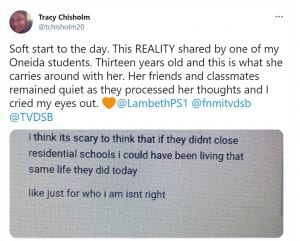The number is staggering. A grave with 215 bodies of Indigenous children. I’m numb with outrage at the discovery. Yet, not naïve to think that this is but a fraction of the over 4000 deaths of children while under the “care” of the residential school system. What other graves have yet to be discovered? What other wounds will be reopened, without a proper plan for lasting healing? This is a history that was never taught to me as a child, but one that I learned in adulthood. I’m thankful for the teachings of Ray John Jr., Starr McGahey-Albert and Robyn Michaud, who over the years have provided me with a glimpse into the lives of our Indigenous students and more importantly a historical perspective about parents and grandparents and their mistrust of the school system. I used to think that “I got it”. I worked in communities where parents had a bad experience with school and therefore projected those worries and concerns on their own children. We needed to work creatively with many families to get them to trust us and to believe that we had their child’s best interests at heart.
But today I realized that “I’ll never get it”. I will never be able to comprehend the pain, suffering and mistrust of a “school” system that not only failed our Indigenous families, but stripped them of a lifetime with their children. It not only took their children with the intent of imparting a culture so juxtaposed to their own, but it also took the lives of their children.
How dare those institutions be referred to as “schools”.
Residential schools started in 1828 and continued into the 1990s. And in the midst of their tenure, the Education Act came into law in 1870, with a purpose of a “strong public education system is the foundation of a prosperous, caring and civil society” I choke on those words now. Is this how a caring and civil society knowingly treats children?
Social media was filled with posts and pictures today, but I want to end this blog post with the Twitter feed from Tracy Chisholm. Tracy works at a school in Lambeth, where they welcome students from Standing Stone school for grades 7 and 8 as the school is currently a JK-6 school. She is a kind, caring and compassionate educator and I have no doubt that her tears continued to flow throughout the day as she supported her students. 
In the midst of this tragic discovery, I’m thankful for educators like Tracy, who cry. Because tears need to flow!

Hi Susan,
Thank you for your response to the residential “schools” legacy. You wrote:
” A strong public education system is the foundation of a prosperous, caring and civil society” I choke on those words now. Is this how a caring and civil society knowingly treats children? ”
I agree with your sentiment that its impossible to “get it” – the way experience of school has been negatively framed for indigenous learners. Why would someone with this concept of schooling every want to sit at a desk. It got me thinking about why school and curriculum approaches are so slow to change to suit the needs of learners in our time. How differently school could be managed in this 21st Century , through the way content can be learner centered instead of subject centered, through Self Regulated Learning projects and student self assessments, through teaching behaviors on self monitoring instead of imposing monitoring for behaviors. I’m excited to try some new approaches in the classroom this term; to add Indigenous literature to my Visual Art and Career Life Ed classes, to create better understanding and appreciation of Indigenous perspectives and ways of learning. I’m really grateful for this post on your site.